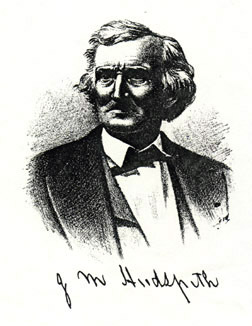
Father: Charles HUDSPETH
Mother: Elizabeth GLEN
Family 1 : Matilda FULLER
_Ralph HUDSPETH ____+
_Giles HUDSPETH _____|
| |_Mary CARTER _______+
_Charles HUDSPETH _|
| | _Philemon BRADFORD _
| |_Elizabeth BRADFORD _|
| |_Mary BIRD _________
|
|--James Madison HUDSPETH
|
| ____________________
| _James GLEN _________|
| | |____________________
|_Elizabeth GLEN ___|
| ____________________
|_Patience GLEN ______|
|____________________
Notes:

|
Listed as Jas M. Hudspeth, a 38 year old farmer born in Alabama with $6000 of Real Estate, in the1850 Sonoma County Federal Census and living with his brother Charles Martin Hudspeth and his family in dwelling #38. Enumerated in the California 1852 Census as J. M. Hudspeth, a 41 year old farmer, born in Alabama, and from Arkansas. He is listed between J. C. Hudspeth and John Adams. Listed in 1860 Census as living in Analy Township with his wife, Matilda. His Real Estate was worth $35,000, personal worth, $20,000. A 14 year old John McDonald from Australia is listed living in the same dwelling. Their dwelling is listed in-between James M. and Mary McReynolds, and Whitely and Ann Travis (a William Travis was a member of the 1853 Hagans-Cockrill immigration). A W. Hudspeth (a. 28, b. MO) is listed on page 498 of the same census. He was a member of John C. Fremont's California Battalion that had come to California in 1846 (where Hudspeth also meet Lansford Hastings). From What I Saw in California, by Edwin W. Bryant (Ross & Haines, Inc, Minneapolis: 1967), p. 367: |
|
Company F. -- L. W. Hastings, captain, (author of a work on California;) Wornbough, 1st lieutenant; J. M. Hudspeth, 2d. do. |
|
|
|
James surveyed the town site for Napa when Nathan Coombs founded the city in 1847. From Dale Morgan's notes to The Overland Diary of James A. Pritchard from Kentucky to California in 1849, p. 144: |
|
Western historians have assumed that the Hudspeth who figures so prominently in the history of 1849 was James M. Hudspeth, best known for his association with Lansford W. Hastings in the opening of the Hastings Cutoff in 1846. However, Thomas Lorraine Campbell (Mrs. Paul Campbell) of Minden, Louisiana, has established that the Forty-niner was Benoni Morgan Hudspeth. She informs me that he was born in 1816 and died in California in 1850, having been a voyager with Fremont in 1845-46, and later an officer in the California Battalion. Four brothers, Robert Nicholas, George Washington, Thomas Jefferson, and Silas Bourke Hudspeth took the trail with him in 1849, as did J. J. Myers. It was this company from Jackson County, Missouri, that opened the Hudspeth Cutoff in Idaho the following July. |
|
|
|
Lansford W. Hastings is also a very interesting character in early California history. His 1845 pioneer trail guide, The Emigrants' Guide to Oregon and California, was an early, practical, "how-to-do-it" book for immigrants to come to the West. However, it had many errors, and in particular the "Hastings' Cutoff," which supposedly had been scouted out with Hudspeth, proved to be fatal to the Donner Party. From a History of Petaluma: A California River Town, by Adair Heig (Scottwall Associates, Petaluma: 1982), p. 69: |
|
Petaluma's own commercial use of [Petaluma] creek began in the summer of 1851, when James Huspeth* built a warehouse near the present Washington Street Bridge; filled with potatoes from Bodega and hay cut on the meadows of Petaluma, and sent the harvest on a boat to Sacramento for sale to Sacramento for sale to miners. * Hudspeth, a state senator from Sonoma County in 1852, is also known for his association with Lansford Hastings, a man who attempted to speed up migration into California by persuading Oregon-bond wagon trains to turn south through Utah and across the desert into California. One train, straggling and late in the westward migration of 1846, yielded to Hasting's persuasion and turned south. That was the Donner Party. |
|
J. M. Huspeth was also said to be William McReynold's partner in the building of the Petaluma warehouse in Santa Rosa, a nineteenth century town (Historia, Ltd., Santa Rosa: c1985), p. 56.
|
This page created on 02/05/01 16:08. Updated 11/05/05 18:12.